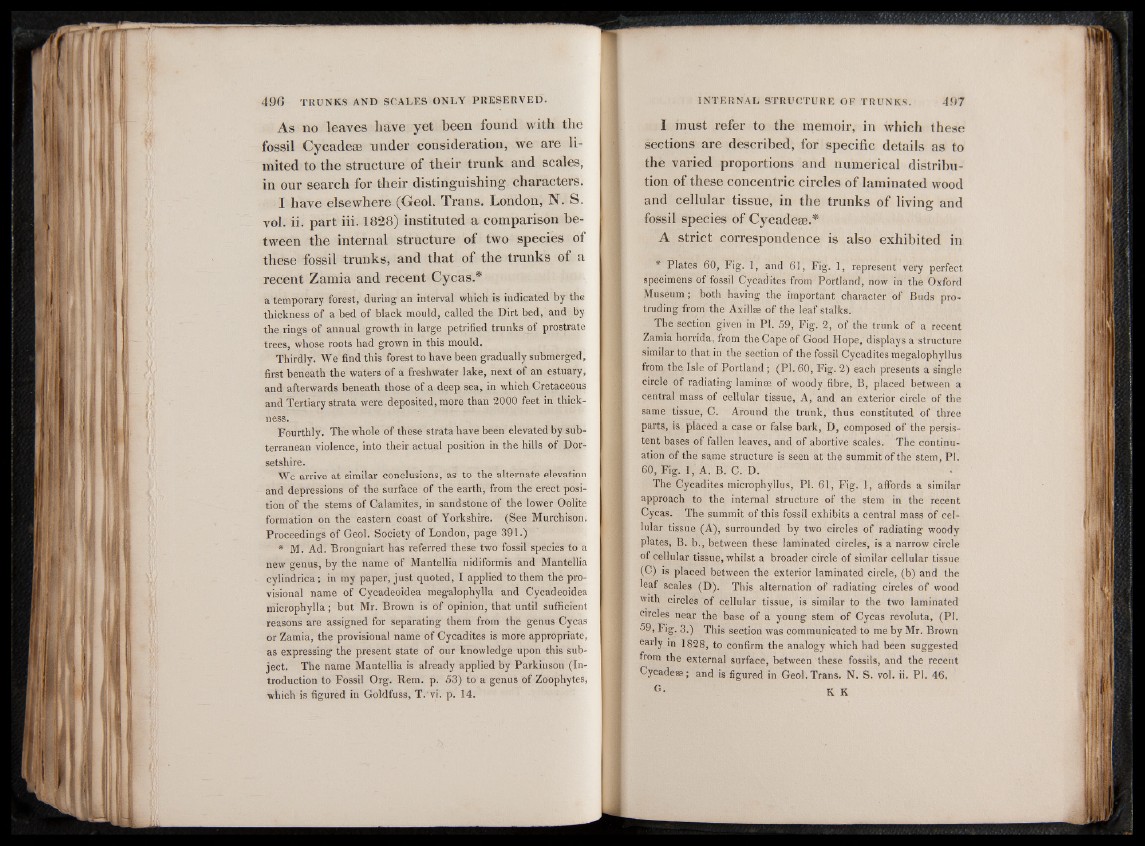
As do leaves have yet been found with the
fossil Cycadeoe under consideration, we are limited
to the structure of their trunk and scales,
in our search for their distinguishing characters.
I have elsewhere (Geol. Trans. London, N. S.
vol. ii. part iii. 1828) instituted a comparison b e tween
the internal structure o f two species of
these fossil trunks, and that o f the trunks o f a
recent Zamia and recent Cycas.*
a temporary forest, during an interval which is indicated by the
thickness of a bed of black mould, called the Dirt bed, and by
the rin°-s of annual growth in large petrified trunks of prostrate
trees, whose roots had grown in this mould.
Thirdly. We find this forest to have been gradually submerged,
first beneath the waters of a freshwater lake, next of an estuary,
and afterwards beneath those of a deep sea, in which Cretaceous
and Tertiary strata were deposited, more than 2000 feet in thickness.
Fourthly. The whole of these strata have been elevated by subterranean
violence, into their actual position in the hills of Dorsetshire.
We arrive at similar conclusions, as to the alternate elevation
and depressions of the surface of the earth, from the erect position
of the stems of Calamites, in sandstone of the lower Oolite
formation on the eastern coast of Yorkshire. (See Murchison.
Proceedings of Geol. Society of London, page 391.)
* M. Ad. Brongniart has referred these two fossil species to a
new genus, by the name of Mantellia nidiformis and Mantellia
cylindrica; in my paper, just quoted, I applied to them the provisional
name of Cycadeoidea megalophylla and Cycadeoidea
microphylla; but Mr. Brown is of opinion, that until sufficient
reasons are assigned for separating them from the genus Cycas
or Zamia, the provisional name of Cycadites is more appropriate,
as expressing the present state of our knowledge upon this subject.
The name Mantellia is already applied by Parkinson (Introduction
to Fossil Org. Rem. p. 53) to a genus of Zoophytes,
which is figured in Goldfuss, T.’vi. p. 14.
I must refer to the memoir, in which these
sections are described, for specific details as to
the varied proportions and numerical distribution
of these concentric circles of laminated wood
and cellular tissue, in the trunks of living and
fossil species of Cycadeae.*
A strict correspondence is also exhibited in
* Plates 60, Fig. 1, and 61, Fig. 1, represent very perfect
specimens of fossil Cycadites from Portland, now in the Oxford
Museum; both having the important character of Buds protruding
from the Axillae of the leaf stalks.
The section given in PI. 59, Fig. 2, of the trunk of a recent
Zamia horrida, from the Cape of Good Hope, displays a structure
similar to that in the section of the fossil Cycadites megalophyllus
from the Isle of Portland ; (PI. 60, Fig. 2) each presents a single
circle of radiating laminae of woody fibre, B, placed between a
central mass of cellular tissue, A, and an exterior circle of the
same tissue, C. Around the trunk, thus constituted of three
parts, is placed a case or false bark, D, composed of the persistent
bases of fallen leaves, and of abortive scales. The continuation
of the same structure is seen at the summit of the stem, PI.
60, Fig. 1, A. B. C. D.
The Cycadites microphyllus, PI. 61, Fig. 1, affords a similar
approach to the internal structure of the stem in the recent
Cycas. The summit of this fossil exhibits a central mass of cellular
tissue (A), surrounded by two circles of radiating woody
plates, B. b., between these laminated circles, is a narrow circle
of cellular tissue, whilst a broader circle of similar cellular tissue
(C) is placed between the exterior laminated circle, (b) and the
leaf scales (D). This alternation of radiating circles of wood
with circles of cellular tissue, is similar to the two laminated
circles near the base of a young stem of Cycas revoluta, (PI.
59, Fig. 3.) This section was communicated to me by Mr. Brown
early in 1828, to confirm the analogy which had been suggested
from the external surface, between these fossils, and the recent
Cycadem; and is figured in Geol. Trans. N. S. vol. ii. PI. 46.
G. K K